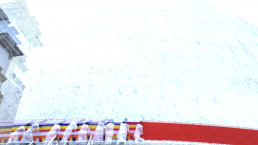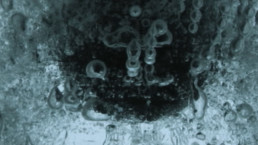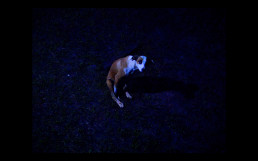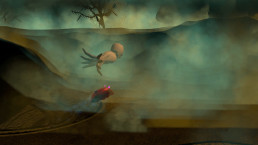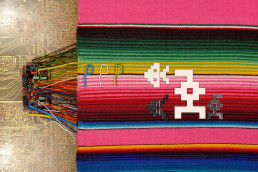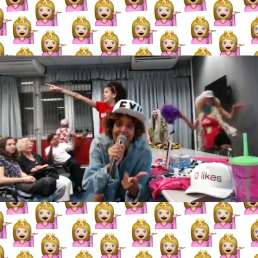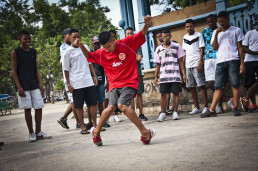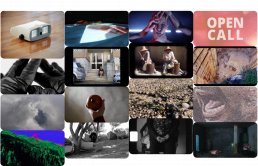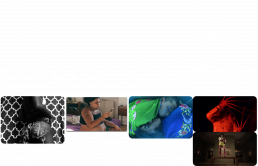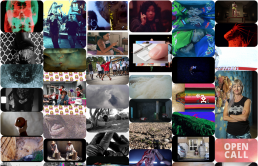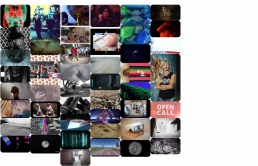“FUSO 2021 – 25 a 29 de Agosto
26 Agosto, 22h00
Museu Nacional de Arte Contemporânea
VOO LIVRE
Daniela Labra (BR)
Esta seleção propõe uma sequência cadenciada e pulsante de trabalhos de artistas com diferentes procedências, pesquisas e linguagens. Trata-se de um apanhado plural de temas contemporâneos transmutados em obras audiovisuais que lidam com questões como espiritualidade, performatividade, Antropoceno, ficção científica, futurologia, transdisciplinaridade, cultura digital, revisões históricas e finalmente a dança como elemento de revolução social. Nosso percurso se inicia no tempo ritualístico expandido budista no Sri Lanka e termina nos corpos periféricos do Rio de Janeiro, Brasil, que evoluem em liberdade, afirmação identitária e pulsão de vida. Assim, o programa vai da epifania espiritual à euforia corporal passando por caminhos de inventividade artística e posições críticas sobre o real e as relações humanas que queremos transformar.
Após um ano e meio de confinamento pandêmico, com muitas perdas afetivas e simbólicas que nos confrontaram com nossa condição fugaz, este programa é uma ode não-mística ao Universo, às forças da natureza, à sensibilidade, inventividade e ao desejo de sobrepassar o medo de viver em tempos de rupturas e crise geral. Para além de fronteiras, normatividades e categorias, que a dança possa ser eterna, os abraços infinitos, as lutas mais fortes e os voos livres.
Daniela Labra
TELEPATIA RITUAL NA CÂMARA-RELÍQUIA, _Himali Singh Soin (IN), 2019, 9’14’’
É uma noite de lua cheia num dia Poya, na estupa Ruwanwelisaya, no Sri Lanka. Os monges envolvem a estupa – de 1000 pés de diâmetro, que contém uma relíquia da clavícula de Buda dentro do seu núcleo impermeável – em tiras de pano, representando as camadas da vida. Talvez estejam a vestir Buda num hábito, talvez estejam a envolver um livro sagrado, ou a vestir algo que esteja a surgir pela primeira vez. As imagens focam-se no quadro natural formado pelos homens que se apoiam no pano à medida que envolvem a base da estupa, mantendo-o em tensão com a força igual e oposta que envolve a esfera.
O que acontece enquanto esperamos pelo pano? Podemos sonhar coletivamente? Podemos suportar o peso juntos? Mover, segurar, esperar, descansar. É nesse potencial que grande parte do vídeo assenta. Entretanto, uma figura do futuro serve como testemunha desta cerimónia, passando por uma transformação própria. Mesmo carregando um coco de prata pós-antropogénico, o cobertor de emergência da figura treme na luz, lembrando-nos da ligação cintilante entre quietude e movimento. O som move-se entre uma nave espacial que gira e o toque de um gongo, proveniente de arquivos encontrados, que ajudam as pessoas a dormir melhor.
VENOSO E ARTERIAL _Rodrigo Braga (BR), 2013, 4’45’’
O vídeo desenrola-se a partir do ponto de vista do artista, que observa uma ação repleta de tensões, próprias do embate da água doce da chuva, que escorre velozmente por uma falésia ao encontro do mar, no litoral de Pernambuco, no nordeste brasileiro. O título é uma alusão ao bombeamento do coração, enquanto as águas de tonalidades e densidades diferentes encarnam correntes vitais que potenciam energias quando se encontram nesse espaço fronteiriço e arriscado.
ALLUVIUM _Erin Coates (AU), 2020, 9’30’’
Alluvium faz parte do projeto Alluvial Gold, que abrange desenho, escultura, vídeo e performance. Erin Coates mergulha no mundo muitas vezes esquecido por baixo da superfície de um rio, para explorar a ecologia em mudança do Rio Swan / Derbarl Yerrigan Bylia (na língua Nyoongar). Em Alluvium, Coates ficciona a biologia da crescente influência da salinidade do estuário do rio Derbarl Yerrigan, que flui através de Perth / Boorloo.
O filme alude à complexa hidrodinâmica, biologia e química do rio e à forma como tem sido alterada nos 200 anos que se seguiram ao estabelecimento da colónia do Rio Swan. A carga de nutrientes causada pelo escoamento de fertilizantes residenciais e da agricultura a montante do rio, aumenta as quantidades de fósforo e nitrogénio na água, causando o florescimento de algas e uma baixa oxigenação.
Os recifes cobertos de mexilhão foram dragados, e espécies invasoras como as ascídias (Didemnum perlucidum) e as algas verde-azuladas, ou cianobactérias (Lyngbya), competem com as gramíneas marinhas nativas. Nos últimos anos, tem-se registado uma elevada mortalidade entre a população residente de golfinhos. Todos os golfinhos que morreram mostraram sinais de morbillivirus (Cetacean Morbillivirus), um vírus que causa lesões circulares na pele. Alluvium é uma especulação sombria sobre a transformação dos ecossistemas fluviais, ao mesmo tempo que destaca a fecundidade e a resiliência das formas de vida dentro desta via aquática urbana.
A percussionista Louise Devenish e o compositor Stuart James criaram uma partitura explorando o potencial de conchas de ostras e de esculturas metálicas.
Um encomenda de Goolugatup Heathcote para o programa de residências e exposições Tilt.
Alluvial Gold teve o apoio do Governo da Austrália Ocidental, através do Departamento de Desporto e Indústrias Culturais do Governo Local.
ILHA NULA _Letícia Ramos (BR). 2020, 6’30’’
A Ilha Null ou Ilha Nula está localizada a 0°N 0°E, onde o Meridiano principal e a linha do Equador se cruzam. O local, no oceano Atlântico, é marcado por uma bóia. Este lugar hipotético só existe em matemática e na cartografia: foi criado para que outros lugares pudessem ser indexados num mapa a partir desta localização. Numa estação meteorológica na Antártica, um cientista e um robô falam através dos tempos. A ciência é o pano de fundo de uma história que fala de isolamento e solidão.
Seguimos a percepção do cientista de um estranho fenómeno que aparece na paisagem polar: uma esfera metálica que não pode ser capturada por câmeras e que é visível apenas aos olhos orgânicos de humanos e animais. O robô – uma forma de inteligência artificial que controla as câmaras – não consegue detetar a esfera e essa discordância sobre o que é visto desencadeia conversas subjetivas e existenciais entre o cientista e o robô.
A temporalidade é fluida, avançando e recuando; entre o presente e o passado, propondo um futuro hipotético. O filme foi feito a partir de imagens apropriadas das webcams localizadas no Laboratório do Sector Escuro da Estação Polo Sul Amundsen-Scott, na Antártica. Nesse local, as câmaras fornecem uma fotografia a cada 90 segundos, que Ramos passou meses a capturar e, em seguida, a compilar numa animação em stop motion.
Os fenómenos naturais que ocorreram na paisagem são então condensados, revelando fenómenos naturais que seriam invisíveis ao olho humano. Null Island contém imagens feitas por Leticia Ramos na Antártica, bem como imagens produzidas a partir de modelos no seu estúdio em São Paulo, feitas durante o confinamento.
Uma encomenda de Jeu de Paume, Paris. Exibido no âmbito do programa “Futurs d‘avant” do Espaço Virtual Jeu de Paume.
CÃES MARINHEIROS _Janaína Wagner (BR), 2020, 7’
Filmado nas pequeníssimas cidades de Velho Airão e Igapó-Açu, na Amazónia Brasileira, Cães Marinheiros justapõe às paisagens em ruínas dos lugarejos o conto homónimo do poeta português Herberto Hélder. Numa inversão perspectivista, as imagens textuais e visuais aparecem e esbatem-se no seio de uma floresta desbastada pelos homens.
Amazónia, Brasil. Na confluência do rio Negro com o rio Jaú encontram-se as ruínas de uma pequena cidade chamada Airão. Fundada por missionários portugueses no ano de 1694, Airão era o ponto de confluência de toda a produção de borracha da região. Após um rápido e insustentável crescimento económico, seguido da decadência do Ciclo da Borracha, a cidade faliu. Um político da época afirmou que a população estava a ser devorada por formigas. Arruinada, Airão foi abandonada.
CORRENTE _Ana María Millán (CO), 2020, 8’07’’
Esta é a história de um grupo de animais marinhos que escapam de um parque aquático no qual são, de maneiras distintas, escravizados. Os animais atravessam canais e arrombam uma parede que lhes permite chegar ao mar aberto, no meio de uma terra estéril e desolada. É também a história de uma perseguição, de um derrame de petróleo no mar e da resposta de uma mulher, treinadora de um tubarão neste mundo marinho artificial, que ocupa uma parte de seu tempo a fazer militância ativista pela conservação ambiental. É também a história da descoberta de um mundo prometido, ainda florescente, nos confins de um planeta sem esperança.
Por detrás desta história, e para além do guião, estão as posições e a capacidade narrativa de um grupo de artistas que, há pouco mais de um ano, foram convidados a realizar uma expedição marítima de duas semanas às Ilhas Salomão. Esta expedição, proposta e financiada por uma instituição austríaca, faz parte de um programa que procura gerar pensamento crítico e propostas artísticas e políticas em torno do impacto do aquecimento global sobre os oceanos do mundo. Millán participou neste processo e durante a viagem de barco conviveu ao longo de duas semanas com os outros artistas, entre eles curadores e escritores, com quem desenvolveu a história a partir de um exercício coletivo de role-play.
Baseado num role-play realizado durante uma TBA-Academy, “The Current II Expedition #2: The Solomon Exercises” dirigida por Chus Martinez.
Com a participação de Ingo Niermann e outros bolseiros da TBA21-Academy Expedition
3D por Ana María Millán e Andres Sandoval Alba
Música por Nicolás Spencer
Este trabalho foi possível através do apoio da TBA 21-Academy.
CHAVÍN Y PIXEL _Marcela Moraga (CL), 2009, 6’20’’
Chavín foi uma civilização pré-colombiana no Peru que desenvolveu um importante estilo artístico. A Arte dos Andes na América do Sul foi fortemente influenciada pelo estilo Chavín. Este estilo baseia-se na integração das disciplinas em função de rituais de transformação espiritual, onde cada elemento − arquitetónico, auditivo, escultórico e visual − se subordina ao uso de simetrias, repetições e linhas curvas. O objetivo era a exaltação de uma transformação física e metafórica. A animação Chavín y Pixel foi realizada usando diferentes tecidos indígenas uma vez que neles se contam histórias e rituais, e se representam visões.
Alguns têxteis foram, inclusive, tecidos com base nas mesmas proporções de construções de grande escala, como os templos em degraus e os campos para os jogos de bola. A decodificação digital das formas arquitetónicas e a sua tradução dos padrões de tecidos baseia-se na transformação de cada nó num pixel. O têxtil andino é uma trama de fios e nós, em formações simétricas, que se organizam numa matriz, numa retícula matemática semelhante à que têm as imagens pixeladas e os circuitos eletrônicos. Em Chavín y Pixel ensaia-se um encontro de divindades Andinas com elementos de videojogos, de forma a exibir uma viagem astral sobre um fundo ou uma “matrix” ancestral.
PÁTRIA _biarritzzz (BR), 2019, 2’15’’
A Pátria é uma mulher hipersexualizada, sedutora e assassina. Uma voz inofensiva que mata e esquece. Neste videoclipe a ironia é trabalhada musicalmente jogando com valores reacionários e patrióticos que circundam a atual sociedade e a política brasileira, como a chamada bancada BBB – Boi, Bala e Bíblia. Esta, reúne representantes da agropecuária, da indústria armamentista e líderes religiosos neo-pentecostais, aliados do atual governo acusado de genocídio pela gestão negligente da pandemia de Covid-19. Ao mesmo tempo, a sigla alude ao programa televisivo de grande audiência Big Brother Brasil. Na colagem de referências da artista também surgem imagens de celebridades do showbiz brasileiro e notícias sobre o extermínio de povos indígenas, acirrado nos anos recentes, entre outras.
Na linguagem de hits das cantoras de baile funk e brega Mc Loma ou Mc Mayara, o trabalho brinca com uma linguagem de memes e de vídeos musicais amadores que são postados no Youtube com imagens literais feitas apenas para acompanhar a letra, criando uma espécie de relação direta do que é visto e falado – quase como cartilhas didáticas alfabetizadoras. É desse trabalho que nasce a pesquisa intitulada #pedagogiasdomeme. O clipe contém excertos apropriados do registo ao vivo da transmissão do colóquio em que o brega funk foi lançado, no auditório de Filosofia da Universidade de São Paulo – USP.
PASSINHO + PASSISTA _Emílio Domingos (BR), 2021, 6’
O célebre sambista Xangô da Mangueira relata que o samba, no começo do século 20, sofria perseguições por parte do poder público. Segundo ele, era comum ter rodas de partido alto interrompidas pela violência policial que as reprimia quebrando os instrumentos dos sambistas. Da mesma maneira, esse abuso de poder ocorre com o funk até os dias atuais. Existem diversos relatos da chegada da polícia em bailes funks disparando tiros contra as caixas de som das equipes. O ocorrido em 2019 em um baile em Paraisópolis, periferia de São Paulo, é um infeliz exemplo disso. O funk é o gênero mais popular entre a juventude do Rio de Janeiro nas últimas décadas e é tido como cultura de massas. O samba, seu antepassado, era o gênero mais popular no início do século passado e, a despeito do seu sucesso, sofreu até ser aceito e consagrado como símbolo da cultura nacional. A corporeidade e os movimentos dos dançarinos, do presente e do passado, possibilitam dançar o passinho ao som do samba e sambar ao som do funk “tamborzão”.
Passinho + Passista é o primeiro trabalho experimental do premiado cineasta documentarista brasileiro Emílio Domingos, e estreia no Fuso Festival 2021.
“FUSO 2021 – 25 a 29 de Agosto
August 26th, 10pm
National Museum of Contemporary Art
FLYING FREE
Daniela Labra (BR)
This selection offers a rhythmic and pulsating sequence of works by artists from different origins, research fields and languages. It is a plural collection of contemporary themes transmuted into audiovisual works dealing with issues such as spirituality, performativity, the Anthropocene, science fiction, futurology, transdisciplinarity; digital culture, historical revisions and, above all, dance as an element of social revolution.
The journey begins in the expanded Buddhist rituals of time in Sri Lanka and ends in the peripheral bodies of Rio de Janeiro, Brazil. This is a journey that evolves in freedom, an identity affirmation and a life drive. Thus, the programme goes from spiritual epiphany to body euphoria, traversing artistic inventiveness and critical positions on the real and the human relations that we want to transform.
After a year and a half of pandemic confinement, with many affected and symbolic losses that have challenged us, this programme is a non-mystical ode to the universe; to the forces of nature, sensitivity, inventiveness and the desire to overcome the fear of living in times of disruption and general crisis. Beyond borders, normalities and categories, let dance be eternal, the embraces infinite, the fight stronger and flight freer.
Daniela Labra
RITUAL TELEPATHY AT THE RELIC-CHAMBER, _Himali Singh Soin (IN), 2019, 9’14’’
It’s a full moon Poya evening at Ruwanwelisaya stupa in Sri Lanka. Monks wrap the stupa–a 1000 ft in diameter with a relic of the Buddha’s collarbone within its impermeable core-in fabric that represents the layers of life. Perhaps they are dressing the Buddha in robes, maybe they are closing a holy book or maybe they are clothing something born for the first time. The imagery focuses on the natural tableau made by the men leaning on the stupa as they straddle their reliance on it and the sphere’s equal and opposite resistive force.
What happens while we wait for the cloth to come around? Can we dream collectively? Can we bear the weight together? Move, hold, wait, rest. It is in this potential that the large part of the video conducts itself. In the meantime, a figure from the future serves as a witness to this ceremony going through a private transformation. Even as they carry a post-anthropogenic silver coconut, the figure’s emergency blanket quivers in the light, reminding us of the shimmering connection between stillness and movement. The sound moves between a spaceship revving and a gong bath, sourced from found archives that assist people in sleeping better.
VENOSO E ARTERIAL _Rodrigo Braga (BR), 2013, 4’45’’
The video unfolds from the artist’s point of view, who is looking at an action full of tensions deriving from the clash of fresh rainwater that flows swiftly from a cliff to meet the sea on the coast of Pernambuco, in the Brazilian northeast. The title alludes to the pumping of the heart. While the waters of different shades and densities embody vital currents that unleash energies when they meet in this risky border place.
ALLUVIUM _Erin Coates (AU), 2020, 9’30’’
Alluvium is a part of the Alluvial Gold project, spanning drawing, sculpture, video and performance. Erin Coates delves into the often-forgotten world below the river surface to explore the changing ecology of the Derbarl Yerrigan/Swan River. In Alluvium, Coates brings a drama to the biology of the Derbarl Yerrigan, a salt wedge estuary flowing through Boorloo/Perth. The film alludes to the complex hydrodynamics, biology and chemistry of the river and the ways these have been changed in the 200 years since the establishment of the Swan River Colony. Nutrient loading caused by runoff from residential fertilisers and upstream agriculture increase the phosphorus and nitrogen in the water, thus promoting algal blooms and low oxygen conditions. The shellfish reefs were dredged from the river and invasive species like the white colonial sea squirt (Didemnum perlucidum) and mermaid’s hair (Lyngbya) compete with native sea grasses. In recent years there have been unusual mortality events among the resident dolphin population. The dolphins that have died all showed signs of tattoo skin disease (Cetacean Morbillivirus), a virus that causes circular skin lesions. Alluvium provides a dark speculation on the transformation of river ecosystems while highlighting the fecundity and resilience of life forms within this urban waterway.
Percussionist Louise Devenish and composer Stuart James have created a musical score by exploring the instrumental potential of Coates’ oyster shell and metallic sculptures.
Commissioned by Goolugatup Heathcote for their Tilt residency and exhibition program.
Alluvial Gold received support from the Government of Western Australia through the Department of Local Government, Sport and Cultural Industries.
NULL ISLAND _Letícia Ramos (BR). 2020, 6’30’’
A Null Island is located at 0°N 0°E, where the prime meridian and the equator cross. The location is marked by a buoy in the Atlantic. This hypothetical place exists only in mathematics and cartography: it was created so that other places could be indexed on a map. At a weather station in Antarctica, a scientist and a robot talk through the ages. Science is the backdrop to a story that speaks of isolation and loneliness. We follow the scientist’s perception of a strange phenomenon that appears in the polar landscape: a metallic sphere that cannot be captured by cameras and is visible only to the organic eyes of humans and animals. The robot – a form of artificial intelligence that controls the cameras – cannot detect the sphere and this disagreement about what is being seen triggers subjective and existential conversations between scientist and robot. The temporality is fluid, going back-and-forth; present and past refers to a hypothetical future. The film was constructed with appropriated images from webcams located in the Dark Sector of the Amundsen-Scott South Pole Station in Antarctica. There, live cameras provide one photograph every 90 seconds, which Ramos spent months capturing and then compiling into a stop motion animation. The natural phenomena that occurred in the landscape were then condensed, revealing natural phenomena that would be invisible to the human eye. Null Island contains footage taken by Ramos in Antarctica, with images produced with models in her studio in São Paulo during lockdown.
Commissioned by Jeu de Paume’s. Showed in “Futurs d‘avant” programme of the Jeu de Paume’s Espace Virtuel.
SAILOR DOGS _Janaína Wagner (BR), 2020, 7’’
Filmed in the small town of Velho Airão and Igapó-Açu, in the Brazilian Amazon. At the convergence of the Negro and the Jaú rivers lay the ruins of Velho Airão. Founded by Portuguese missionaries in 1694, Airão was the point where all the rubber production in the region was concentrated. After a fast and unsustainable economic growth, followed by the decay of the Rubber Cycle, the city went bankrupt. A politician from that time stated that the population was being devoured by ants. Once in ruins, Airão was abandoned.
STREAM _Ana María Millán (CO), 2020, 8’07’’
Stream is the story of a group of marine animals that escape from a water park in which they are, in different ways, enslaved. The animals swim across canals and break through a wall that allows them to reach the open sea, in the middle of a barren and desolate land. It is also the story of a persecution, an oil spill at sea, and the response of a woman, a trainer of a shark in this artificial marine world, who occupies a part of her time campaigning for environmental conservation. It is also the story of the discovery of a promised world, still flourishing, in the confines of a hopeless planet.
Behind the story, and beyond the script, are the positions and narrative capacity of a group of artists who, just over a year ago, were invited to undertake a two-week maritime expedition to the Solomon Islands. This expedition, proposed and financed by an Austrian institution, is part of a programme that sought to generate critical thinking and artistic and political proposals around the impact of global warming on the world’s oceans.
Millán participated in this process and during the boat trip she lived with the other artists, curators and writers, with whom she developed the story from a collective role-play exercise.
Based on the role-play done during the TBA-Academy, “The Current II Expedition #2: The Solomon Exercises” led by Chus Martinez.
With the participation of Ingo Niermann and other Fellows of TBA21-Academy Expedition
3D by Ana María Millán and Andres Sandoval Alba
Music by Nicolás Spencer
This work was made possible with the support from the TBA21-Academy.
CHAVÍN Y PIXEL _Marcela Moraga (CL), 2009, 6’20’’
Chavín was a pre-Columbian civilization in Peru that developed an important artistic style. The Art of the Andes in South America was heavily influenced by the Chavín style. This style was based on the integration of disciplines in function of rituals of spiritual transformation, where each architectural, auditory, sculptural, and visual element was subordinated to the use of symmetries, repetitions, and curved lines. Everything was aimed at the exaltation of a physical and metaphorical transformation. The animation Chavín y Pixel was done using different indigenous fabrics, since they tell stories and rituals themselves, representing visions.
Some textiles were even woven based on the same proportions of large-scale buildings, such as step temples and ball courts. The digital decoding of architectural shapes and their translation of the fabrics’ patterns is based on the replication of each node into a pixel. The Andean textile is woven with threads and knots, in symmetrical formations, which are organized in a matrix composed by a weft of threads, in a mathematical reticule similar to pixelated images and electronic circuits. In Chavín y Pixel, a meeting of Andean deities with videogame elements is carried out to visualize an astral journey or an ancestral “Matrix”.
PÁTRIA _biarritzzz (BR), 2019, 2’15’
Pátria is a hypersexualized, seductive, and murderous woman. A harmless voice that kills and forgets. In this video clip, the irony is musically worked, playing with the reactionary and patriotic values that surround the current Brazilian society and politics, the so-called BBB – Boi, Bala e Bíblia (Ox, Bullet and Bible). It brings together representatives of agriculture, the arms industry and religious neo-Pentecostal leaders, allies of the current government, who are accused of genocide for its negligent management of the Covid-19 pandemic. At the same time, the acronym alludes to the television program Big Brother Brasil. In the collage of the artist’s references, we can find images of Brazilian showbiz celebrities, as well as news about the extermination of indigenous peoples in recent years, among others.
In the language of baile funk and brega hits by singers like Mc Loma or Mc Mayara, the work plays with a language of memes and amateur music videos that are posted on Youtube. They show literal images fitting with the lyrics, creating a direct relationship between what is seen and spoken – almost like educational literacy booklets. It is from this work that the research entitled #pedagogiasdomeme (#pedagogiesofthememe) is born. The clip also appropriates scenes from the live broadcast of the colloquium in which brega funk was launched, at the auditorium of Philosophy of the University of São Paulo – USP
PASSINHO + PASSISTA _Emílio Domingos (BR), 2021, 6’
The famous samba singer Xangô da Mangueira recounts that at the beginning of the 20th century, Samba was oppressed by the government. According to Domingos, it was common to have rodas de partido alto [a samba danced by a party (partido) – a union of men sharing the same ideas] interrupted by police violence that oppressed them by destroying the instruments of the sambistas. This abuse of power occurs with Funk music up to the present day and there are several reports of the police arriving at Funk events and firing shots at the teams’ sound systems. What happened in 2019 at an event in Paraisópolis, on the outskirts of São Paulo, is an unfortunate example of this.
Funk is the most popular musical genre among the youth of Rio de Janeiro in recent decades and is regarded as a mass culture. Samba, its ancestor, was the most popular genre at the beginning of the last century and, despite its success, it was discriminated against until it was accepted and enshrined as a symbol of national culture. The corporeality and movements of the dancers, of the present and of the past, make it possible to dance the passinho (short step) to the sound of samba and dance to the sound of funk tamborzão (big drum).
Passinho + Passista is the first experimental work of award-winning Brazilian documentary filmmaker Emílio Domingos, and premieres at Fuso Festival 2021.
